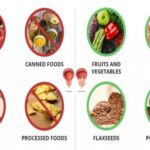The Best Fluffy Pancakes recipe you will fall in love with. Full of tips and tricks to help you make the best pancakes.

Diabetes has become an increasingly concerning health issue, with over 34 million Americans currently living with diabetes.
The disease can lead to a number of dangerous complications like nerve damage, kidney disease, vision loss, and cardiovascular problems if not properly managed.
The good news is that simple lifestyle changes like maintaining a healthy diet can dramatically impact blood sugar levels and diabetes outcomes.
Whether you have been recently diagnosed or have been living with diabetes for years, implementing the nutritional recommendations in this guide can help you gain control of your blood sugar levels, prevent complications, and thrive with diabetes.
Key Takeaways
Managing diabetes without the use of supplement but through food and nutrition is challenging but incredibly impactful. To summarize this guide, focus on these key takeaways:
- Focus on Fiber: Prioritize high-fiber foods like vegetables, whole grains, and legumes to regulate blood sugar levels effectively.
- Choose Lean Proteins: Opt for lean proteins such as poultry, fish, and tofu to promote satiety without causing glucose spikes.
- Incorporate Healthy Fats: Include sources of healthy fats like nuts, seeds, and avocado to maintain insulin sensitivity and support overall health.
- Mindful Carbohydrate Consumption: Monitor carbohydrate intake, favoring fruits with a low glycemic index such as berries and apples, while avoiding sugary beverages and processed snacks to manage blood sugar levels effectively.
- Base meals around low glycemic index foods – Focus on foods that do not cause large or sudden blood sugar spikes – mainly non-starchy vegetables, whole grains, nuts, seeds, fatty fish, and certain low glycemic fruits.
- Incorporate lean protein with each meal – Protein sources like chicken, salmon, tofu, eggs, dairy and plant-based proteins help control appetite and prevent blood sugar fluctuations.
- Pay attention to labels and ingredients – Read labels to make informed choices and avoid items with added sugars, refined grains and unhealthy fats. Beware of packaged “diet foods”. Focus on whole, single-ingredient foods.
- Use Healthy blood sugar support Tea with no side effects as we have with supplements
5 Best Food Choices for Diabetics
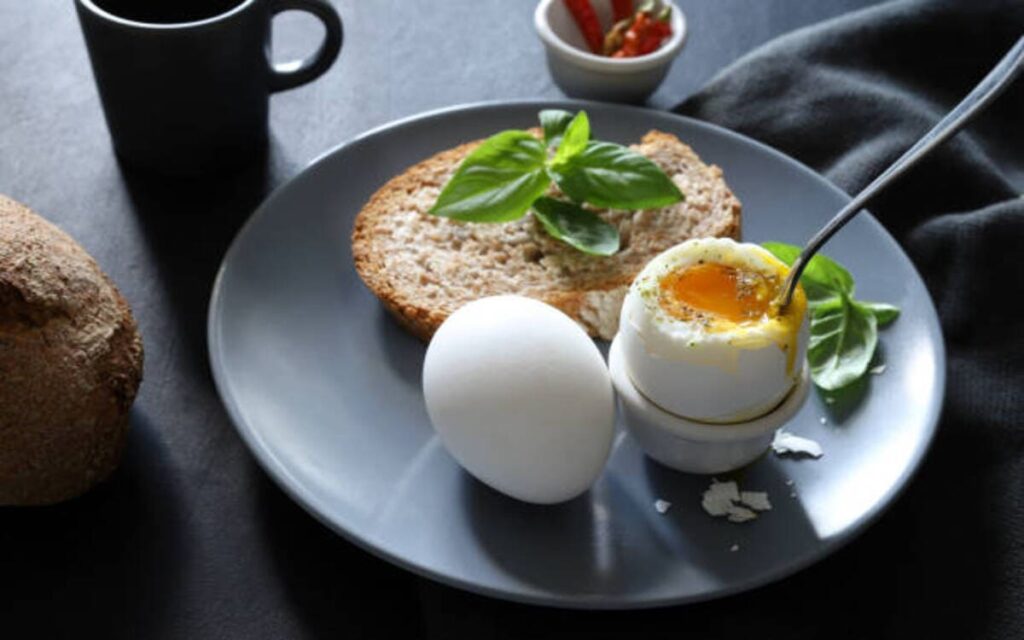
Now that we have covered the key nutrient priorities, let’s explore practical examples of the best food choices across every major food group. Focusing on these diabetes superfoods will allow you to craft balanced, nutritious meals.
1. Non-Starchy Vegetables
Non-starchy vegetables should make up a good portion of any diabetic diet. They provide antioxidants, fiber, vitamin C, calcium, potassium and magnesium with minimal impact on blood sugar.
- Best options: leafy greens, broccoli, carrots, peppers, onions, mushrooms, cauliflower, green beans, celery, eggplant, tomatoes
Aim to incorporate non-starchy veggies into every meal. roasting, sautéing, or grilling can boost flavor.
2. Whole Grains
Whole, minimally processed grains with their bran and germ intact pack valuable vitamins, minerals and fiber that finely ground refined grains lack.
- Best options: oats, brown rice, farro, quinoa, buckwheat, bulgur, whole grain barley
Pair with plant-based protein for balanced nutrition and aim for at least half your grain intake to be 100% whole grain.
3. Legumes
All varieties of beans, lentils, peas and peanuts provide ample fiber to help with blood sugar regulation. They also deliver a hefty dose of plant-based protein in each serving.
4. Nuts and Seeds
Nuts and seeds offer healthy monounsaturated and polyunsaturated fats, plant-based protein, fiber and key micronutrients like magnesium. Individualize your choices based on tolerance, as some struggle to digest nuts.
5. Fatty Fish
Cold water oily fish like salmon and sardines contain omega-3 fatty acids that reduce inflammation and risk of cardiovascular disease – major concerns for diabetics.
6. Lean Dairy
Low-fat milk, yogurt and cheese can fit into a diabetic diet in moderation. Opt for plain, unsweetened varieties over flavored milk and fruit yogurts high in sugar.
7. Fruits
Fruit can be part of a healthy diabetic diet in moderation due to its natural sugar content. Focus on fruits that are higher in fiber and nutrients relative to their glycemic load:
- Best options: berries, grapefruit, peaches, plums, pears, cherries, apples, oranges
You cab also read about meal planning strategies for diabetics.
Meal Planning Tips for Diabetics
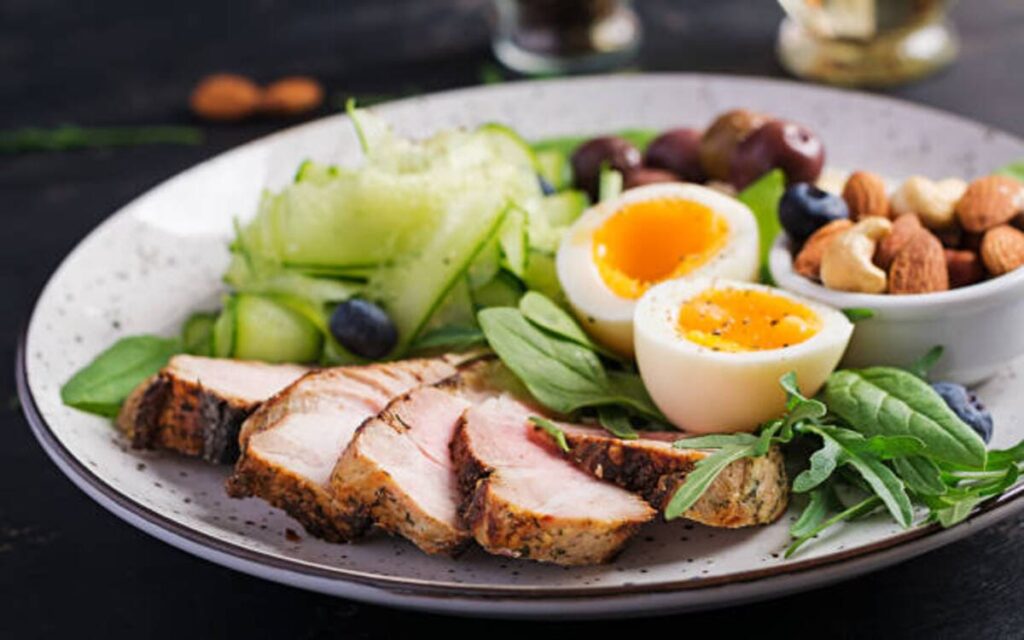
Now that you know which foods to focus on, let’s explore some meal planning strategies to make nutritious choices easy and sustainable.
Practice Portion Control
Paying attention to proper serving sizes is key. Use smaller plates, weigh and measure foods, and avoid going back for seconds to prevent overeating.
Time Your Meals
Eat consistently every 4-5 hours throughout the day to prevent intense hunger leading to poor choices. Also test glucose before and after meals to understand your body’s response.
Read Labels
Get in the habit of reading nutrition labels so you understand exactly what you are putting into your body. Look for red flags like added sugars, unhealthy fats and excessive sodium.
Also Read: Top-Rated Peripheral Neuropathy Physical Therapy Exercises that Stop Pain & Enhanced Mobility
Cook Smart
Grill, roast, bake or stir fry dishes instead of deep frying in lots of oil. Season vegetables and lean meats with herbs, spices, garlic, lime and other flavors to make meals satisfying.
Here are some examples of balanced meals and snacks you can easily whip up:
- Veggie omelet with avocado toast
- Stir fried tempeh bowl with brown rice and broccoli
- Greek yogurt parfait with nuts, chia seeds and berries
- Tuna salad stuffed in tomatoes alongside carrot sticks
- Burrito bowl with chicken, brown rice, beans, salsa and guacamole
With practice, you will get better at whipping up simple but nutritious options tailored to your preferences and health needs.
These meals provide balanced nutrition to keep you feeling satisfied and avoid challenging blood sugar spikes and crashes.
Now let’s wrap up with answers to your most frequently asked questions about the diabetic diet.
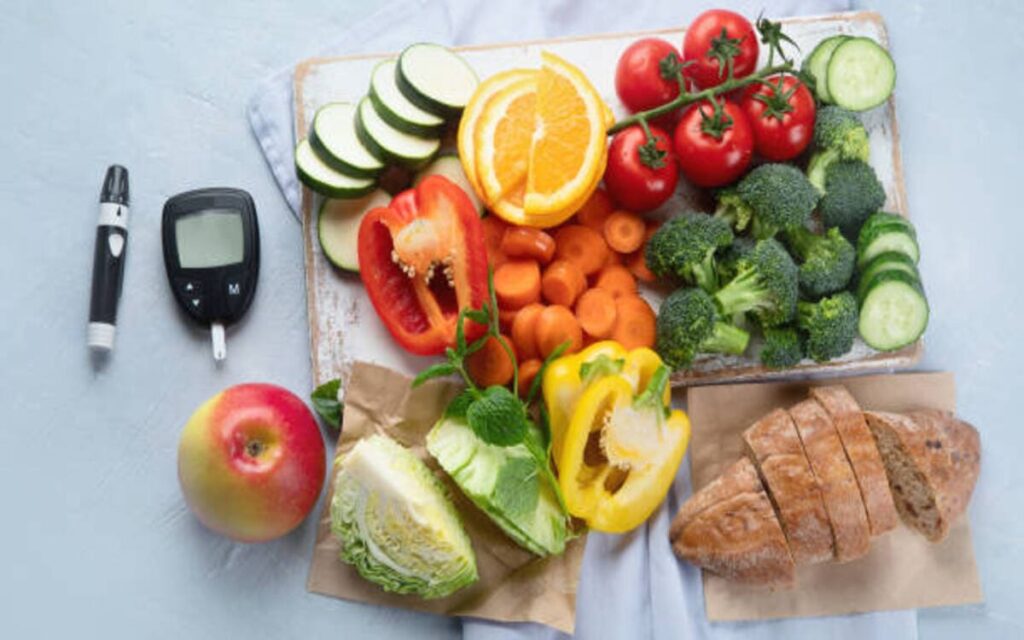
Question: What are the best things for diabetics to eat to manage their condition effectively?
Answer: The best things for diabetics to eat include high-fiber foods like vegetables, whole grains, and legumes, which help regulate blood sugar levels.
Lean proteins such as poultry, fish, and tofu aid in satiety without spiking glucose. Incorporating healthy fats from sources like nuts, seeds, and avocado helps maintain insulin sensitivity.
Fruits with a low glycemic index, such as berries and apples, offer sweetness without causing sharp sugar spikes. Portion control and mindful carbohydrate consumption are key strategies, while avoiding sugary beverages and processed snacks is crucial for effective diabetes management.
Regular monitoring of blood sugar levels and consultation with healthcare professionals are also vital components of a diabetic-friendly diet.
Understanding Diabetes and Diet
Diabetes is a chronic health condition characterized by elevated blood sugar levels. With diabetes, either the pancreas cannot produce enough insulin, or the body cannot properly utilize the insulin that is produced.
Recommended Article: Tired of Agonizing Sciatica? – Say Goodbye to Sciatica Nerve Pain Misery in Just 5 Minutes
There are two main types of diabetes:
- Type 1 Diabetes – An autoimmune disease where the pancreas stops making insulin. It often first appears in children and young adults and requires insulin treatment.
- Type 2 Diabetes – The more common form accounting for 90-95% of cases. Occurs when the body becomes resistant to insulin or doesn’t make enough. More prevalent in those over 45 who are overweight.
No matter the type or cause, the end result is abnormally high levels of glucose (sugar) in the bloodstream, which can lead to widespread damage of blood vessels and nerves over time.
But here is the good news – although diabetes is a serious condition, the progression of the disease can be dramatically slowed and even reversed through lifestyle changes like adopting a healthy diet.*
Specifically, paying attention to the types of nutrients, source of calories, glycemic load of foods, and portion sizes can help individuals with diabetes manage blood sugar fluctuations and maintain stability.
Balancing carbohydrates, protein, and healthy fats while focusing on nutrient-dense whole foods is key for overall health. Understanding these concepts sets the stage for making optimal meal choices.
Recommended Article: New Gluco Savior “Sugar Hack” Secretly Reverses Diabetes
Let’s now break down the most nutritious foods for diabetics in more detail.
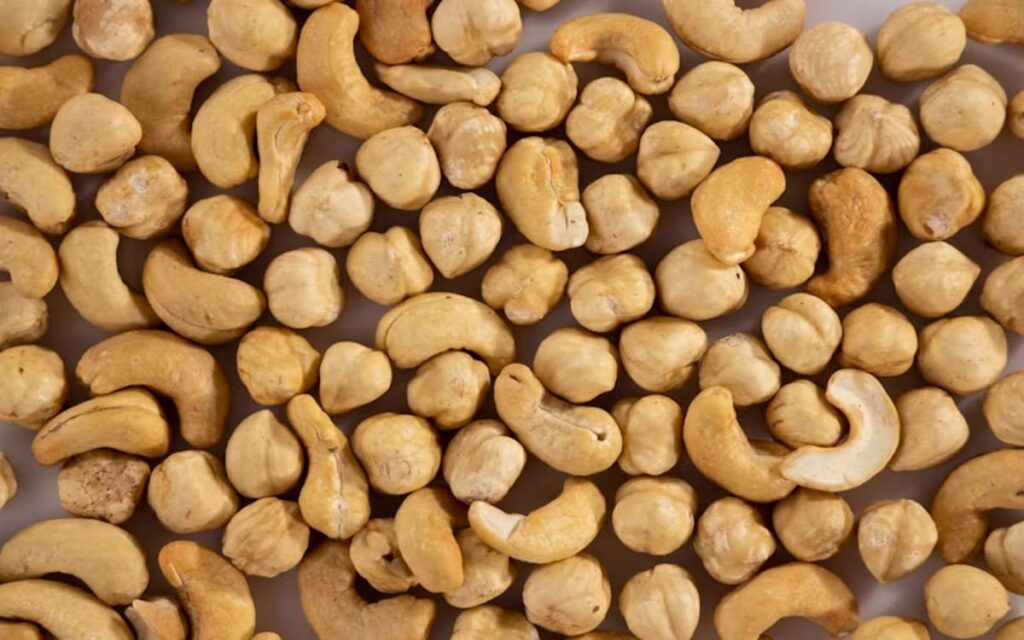
Nutrient-Rich Foods for Diabetics
When it comes to managing diabetes through food, focusing on dishes and ingredients that provide a powerhouse of nutrition is crucial. There are certain categories of foods that rise above the rest when it comes to balancing blood sugar.
Focus on Fiber-Rich Foods
Consuming adequate fiber is highly beneficial for individuals with diabetes. Fiber-rich foods help regulate fat and carbohydrate digestion, promote feelings of fullness, and stabilize glucose and insulin output. Great high fiber options include:
- Whole grains – oats, quinoa, brown rice, whole grain pasta, Ezekiel bread
- Fruits & vegetables – especially leafy greens and berries
- Legumes and lentils
- Nuts and seeds
- Low-sugar bran cereals
Eating a variety of high fiber foods is key for maintaining steady energy levels and blood sugar balance.
Choose Healthy Fats
Despite their high calorie count, healthy fats play a crucial role in the diabetic diet. Monounsaturated and polyunsaturated fats found in foods like olive oil, avocados, nuts, seeds and fatty fish provide essential fatty acids that reduce inflammation, cholesterol levels, and heart disease risk.
Also Learn: Diabetes Treatment: “Why Do Doctors No Longer Prescribe Metformin”
In moderation, these healthy fat sources support stable blood sugar regulation.
Pick Lean Protein
Diabetics have specific protein needs related to kidney function and nutrient uptake. Protein also helps control hunger urges and observed rises in blood glucose levels.
Excellent lean protein choices include:
- Skinless poultry
- Fish and seafood
- Eggs and egg whites
- Tofu
- Greek yogurt
- Low-fat dairy products
- Plant-based protein powder
When combined with complex carbs and fiber, lean protein makes up the foundation of a balanced diabetic diet.
Stay Hydrated
One of the simplest but most crucial elements of managing diabetes is staying properly hydrated. Water helps the kidneys efficiently filter excess glucose from the bloodstream. Skip the sugary drinks, and stick with unsweetened options:
- Plain water
- Sparkling water
- Unsweetened tea
- Black coffee
Drinking adequate fluids is vital for clearing glucose from the system.
The next section will cover specific examples of diabetes superfood options across all the major food groups.
Recommended Article: New Gluco Savior “Sugar Hack” Secretly Reverses Diabetes
Related Article: Advanced Nerve Support – Life-Changing Neuropathy Formula
FAQs on 5 Best Things For Diabetics To Eat To Blood Sugar Below 100
Q: What are the best snacks for diabetics?
A: Smart snacking is important for maintaining stable blood sugar levels. Some of the best options include fresh fruits and vegetables, nuts, seeds, hard boiled eggs, yogurt, cottage cheese, or a small serving of whole grain crackers.
Q: Which fruits are best for diabetics to eat?
A: The fruits lowest on the glycemic index like berries, grapefruit, peaches, pears and apples cause the least blood sugar spike. Limit fruit juices which lack fiber and contain concentrated sugars.
Q: Should carbohydrates be avoided in the diabetic diet?
A: Not necessarily. Focus should be on getting carbohydrates from high fiber whole food sources like whole grains, beans, lentils, fruits and starchy vegetables. Limit processed refined carbs like white bread, pasta and baked goods.
Q: How much sugar per day is considered safe for diabetics?
A: American Diabetes Association guidelines recommend limiting added sugar to no more than 25 grams or 6 teaspoons per day for women and 36 grams or 9 teaspoons daily for men.
Q: What types of drinks are suitable for diabetics besides water?
A: Unsweetened coffee, tea, seltzer waters and moderate amounts of low-fat dairy milk tend to be suitable options. Always avoid sugary sodas and fruit juices high in natural sugars.
Q: Can artificial sweeteners be safely consumed by diabetics?
A: Sugar substitutes like stevia and erythritol appear to have little effect on blood glucose and insulin and can be used to satisfy a sweet tooth. However moderation is still key.
Q: How can I satisfy my sugar cravings to prevent cheating on my diet?
A: When cravings hit, go for a natural sweet whole food like fruit or berries. Dark chocolate in moderation can also curb sweet cravings. Finally, make sure you are eating balanced meals to avoid getting too hungry.
Let me know if you have any other questions! Proper nutrition can seem complicated at first but gets easier with education and practice.
Conclusion:
The best things for diabetics to eat include high-fiber foods like vegetables, whole grains, and legumes to regulate blood sugar levels.
Lean proteins such as poultry, fish, and tofu aid in satiety without spiking glucose. Healthy fats from sources like nuts, seeds, and avocado help maintain insulin sensitivity.
Fruits with low glycemic index, like berries and apples, offer sweetness without causing sharp sugar spikes. Portion control and mindful carbohydrate consumption are key.
Avoiding sugary beverages and processed snacks is crucial. Consistent monitoring of blood sugar levels and consulting with a registered dietitian or healthcare professional are essential for personalized dietary management.
Along with regular exercise and monitoring blood sugar levels, following these diet principles can help manage diabetes, prevent complications and support overall health.
With a little planning and guidance around meal choices, living an active, nourishing life with diabetes is entirely achievable. Here’s to taking control of your health!
References
Here are authoritative reference article links related to the best things for diabetics to eat:
https://www.medicalnewstoday.com/articles/282929
This Medical News Today article covers optimal food choices for a diabetic diet, including non-starchy vegetables, whole grains, lean proteins, healthy fats and low glycemic index fruits.
https://www.health.harvard.edu/diseases-and-conditions/the-best-diet-for-diabetes
This Harvard Health article provides research-based guidance on the best dietary pattern for managing diabetes, with a focus on fiber-rich carbohydrate sources, plant-based protein, and healthy fats.










